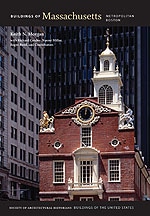
The construction of this apartment hotel that dwarfed its early-nineteenth-century neighbors caused a public outcry in 1885, leading to measures to protect the vista of the Massachusetts capitol. In 1899 a law imposed height restrictions for new construction in the vicinity. The tour de force Queen Anne design for The Tudor consists of an accretion of popular architectural motifs from various stylistic periods. The quarry-faced sandstone base remains Romanesque, while the five stories above combine the traditional Boston bowfront with Queen Anne oriel windows. Above the cornice rise two more stories in a partial mansard ornamented with dormers and more oriel windows. S. J. F. Thayer maximized natural light for the occupants on the Joy Street facade. Ascending Joy Street adjacent to The Tudor, the row of four-story bowfront town houses at 1–5 Joy Street (1832–1834, Cornelius Coolidge) anticipates what will become a common pattern in the South End at midcentury.

